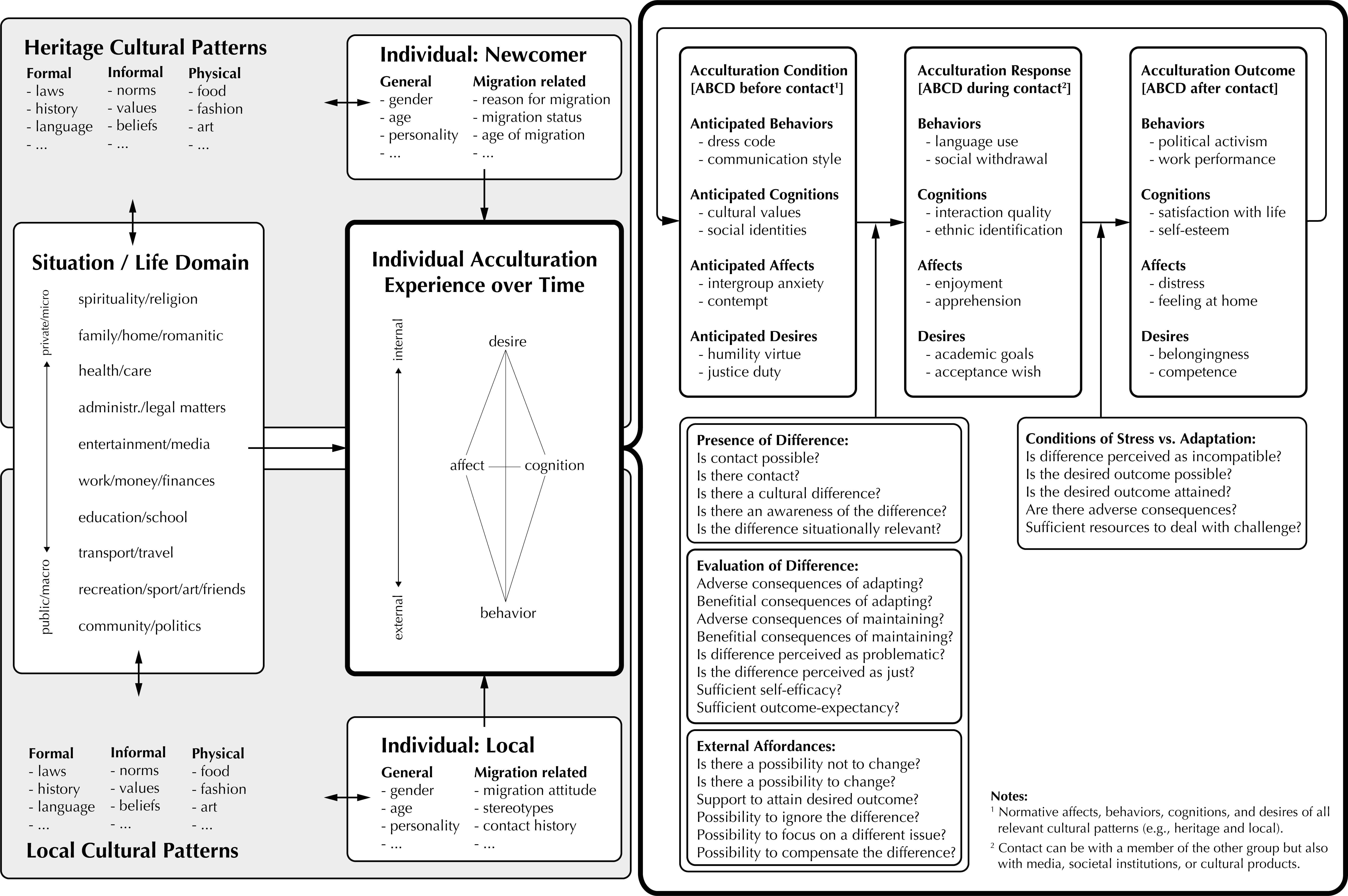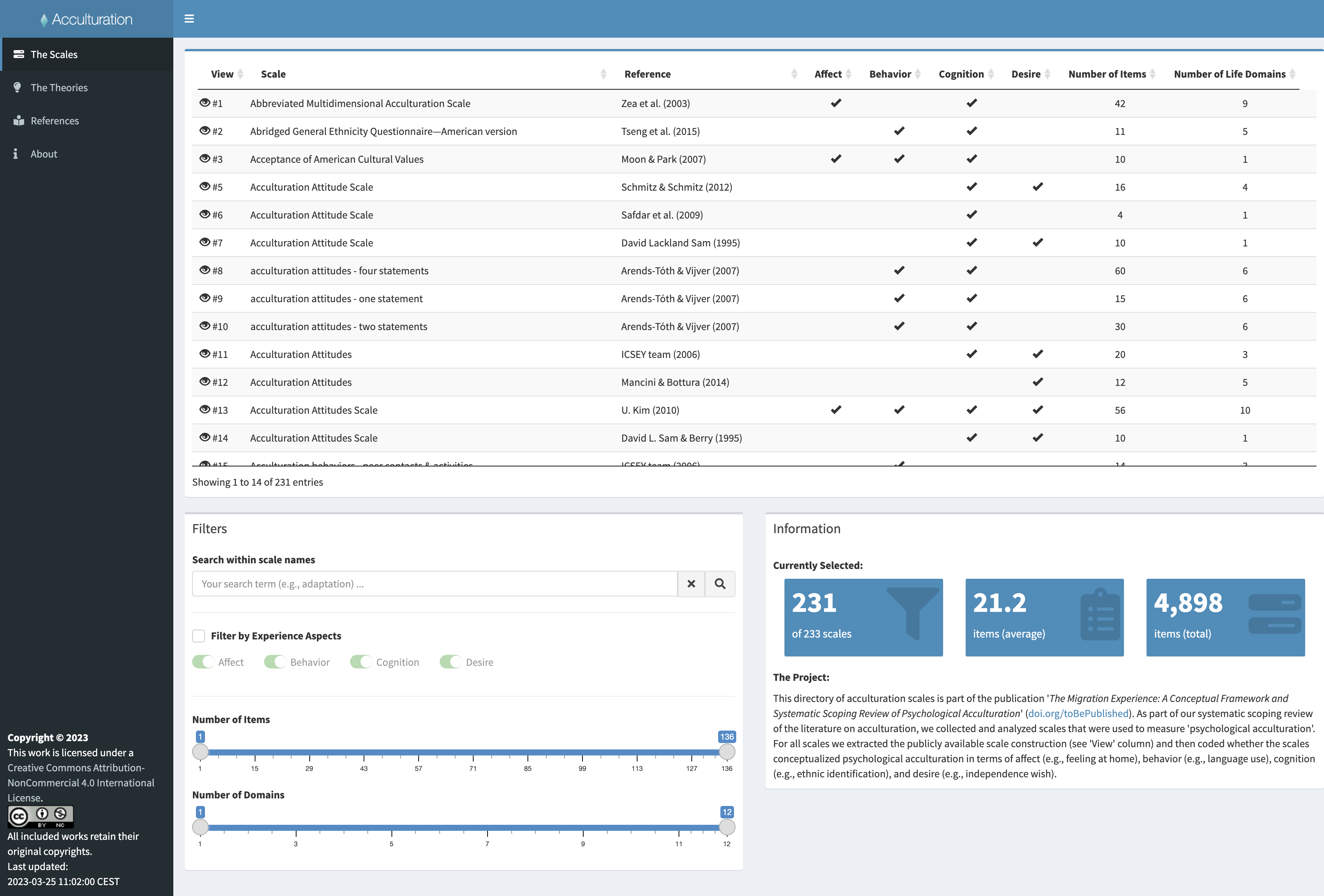As part of my PhD project, my collaborators and I have been working on a comprehensive way of organizing the many different aspects of psychological acculturation (i.e., the question of how people change when they get into continuous first-hand contact with other cultures). The project has been published as a Personality and Social Psychology Review article and is freely avialable under an open access license. Below, I introduce some of effort’s background and output. For an academic conference, I prepared a short introduction video a while ago, which might offere a simple (albeit slightly outdated) entry to the project.
The Review
One of the key challenges to researching psychological acculturation is an immense heterogeneity in theories and measures. These inconsistencies make it difficult to compare past literature on acculturation, hinder straight-forward measurement selections, and hampers the development of an overarching framework. To structure our understanding of the migration process, we propose to utilize the four basic elements of human experiences (wanting, feeling, thinking, and doing) as a conceptual framework. We use this framework to build a theory-driven literature synthesis of past theoretical (final N = 92), methodological (final N = 233) and empirical literature (final N = 530). We find that especially empirical works have understudied the more internal aspects of acculturation (motivations and feelings) and have often fallen short of capturing all four aspects of the migration experience. We also show differences between publication fields and discuss how the framework can aid transparent and functional theories, studies, and interventions going forward.
The Framework
To build a framework that would comprehensively structure the concept of psychological acculturation across a wide range of contexts, we propose to utilize the basic elements of human experiences. Building on conceptual developments within the acculturation literature, we propose that the psychological acculturation experience can be understood in terms of affects, behaviors, cognitions, and desires. Psychological acculturation in this framework might, for example, be understood or measured in terms of behavioral acculturation, such as language use, or voting; cognitive acculturation, such as ethnic identification, or cultural values endorsement; affective acculturation, such as feeling at home, or loneliness; motivational acculturation, such as the satisfaction of competence or independence needs; or as a combination of any or all of these aspects. Coding the available acculturation theories, and scales identified during the systematic scoping review inspired the creation of this directory and the chosen filter options.
Three major contextual factors often found within the literature are the relevant cultural patterns, the contact situation, as well as the interacting individuals. All of these contextual elements will likely have a profound impact on the experience of affects, behaviors, cognitions, and desires. As part of the directory we present here, we list the situational context that is captured in the acculturation scales. One way of structuring this situational context is what we will here refer to as the life domains — the idea that the social experience will take place within different domains in life. Based on sociological theories of social institutions (Durkheim, 1982), literature on life domains in acculturation (Arends-Tóth & van de Vijver, 2006, 2007; Zane & Mak, 2004), a categorization of psychological influences by the British Psychological Society (Michie et al., 2005), and Bronfenbrenner’s Ecological systems theory (Bronfenbrenner, 1992), we conceptualized a range of life domains relevant to the migration process (also see Figure 1). These life domains are exlicitly or indirectly the target of many acculturation scales. We list all domains that were explicitly refered to by the authors of the scales (within the scale pop-up box, via the ‘View’ button) and offer the option to filter scales by the number of life domains they address.
 Figure 1: Conceptual Framework with Context from the main manuscript.
Figure 1: Conceptual Framework with Context from the main manuscript.
The Acculturation Directory
As part of the systematic scoping review, we collected and coded a wide range of theoretical and methodological manuscripts on psychological acculturation. From the literature, we were able to collect and code 233 acculturation scales as well as 93 acculturation theories. Given that this undertaking, to the best of our knowledge, brought together the largest collection of acculturation scales and theories to date, we decided to make the scales and theories as well as their attributes accessible to the readership. To this aim, we created an interactive acculturaction directory. This directory has three main functions, as it aims to (1) aid selection, (2) accessibility, and (3) exploration of the review results.
The most practical function of this application is to aid researchers and practitioners in the selection of acculturation measurements and theories. The study of acculturation has produced an immense number of acculturation scales and theories. As a result, making a choice between these different approaches can be difficult. Not only is it difficult to gain an overview of the number of approaches used within the literature, but also the diversity in style and content can be overwhelming. We hope that the filter options we provide in our application can offer a first structured and intuitive entry into the plethora of acculturation scales and theories. It should be noted that this directory is not meant to replace a full literature review and only present a small amount of information on the scales and theories.
We also hope to make the scales and theories more easily accessible to the users of the application. We do so by showcasing all (publicly) available scale items by clicking the eye icon in the ‘View’ column. We, additionally, list the full references to all works in the References tab (linked via a ‘Reference’ column in the scale and theory directories).
And finally, as part of the framework development and systematic review, we have arrived at a number of conclusions about the theoretical and methodological literature on acculturation. We hope that readers can use this directory in conjunction with the main article and explore the results themselves. The data tables and the appended filter allow readers interactive access to the data and users might gain an intuitive understanding of the current state of the literature.
 Figure 2: Acculturation Directory.
Figure 2: Acculturation Directory.

